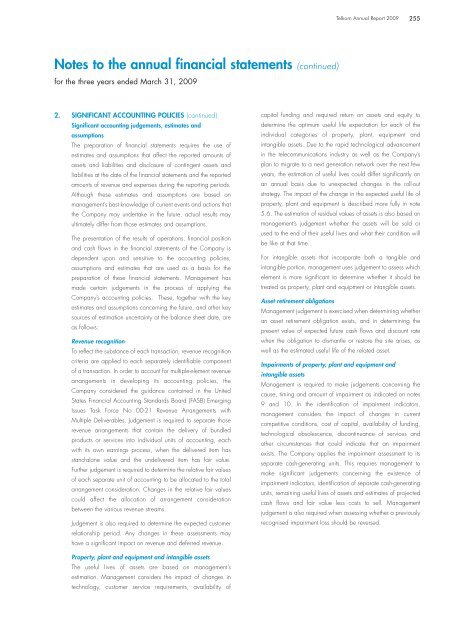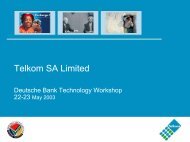Telkom AR front.qxp
Telkom AR front.qxp
Telkom AR front.qxp
You also want an ePaper? Increase the reach of your titles
YUMPU automatically turns print PDFs into web optimized ePapers that Google loves.
Notes to the annual financial statements (continued)<br />
for the three years ended March 31, 2009<br />
2. SIGNIFICANT ACCOUNTING POLICIES (continued)<br />
Significant accounting judgements, estimates and<br />
assumptions<br />
The preparation of financial statements requires the use of<br />
estimates and assumptions that affect the reported amounts of<br />
assets and liabilities and disclosure of contingent assets and<br />
liabilities at the date of the financial statements and the reported<br />
amounts of revenue and expenses during the reporting periods.<br />
Although these estimates and assumptions are based on<br />
management’s best knowledge of current events and actions that<br />
the Company may undertake in the future, actual results may<br />
ultimately differ from those estimates and assumptions.<br />
The presentation of the results of operations, financial position<br />
and cash flows in the financial statements of the Company is<br />
dependent upon and sensitive to the accounting policies,<br />
assumptions and estimates that are used as a basis for the<br />
preparation of these financial statements. Management has<br />
made certain judgements in the process of applying the<br />
Company’s accounting policies. These, together with the key<br />
estimates and assumptions concerning the future, and other key<br />
sources of estimation uncertainty at the balance sheet date, are<br />
as follows:<br />
Revenue recognition<br />
To reflect the substance of each transaction, revenue recognition<br />
criteria are applied to each separately identifiable component<br />
of a transaction. In order to account for multiple-element revenue<br />
arrangements in developing its accounting policies, the<br />
Company considered the guidance contained in the United<br />
States Financial Accounting Standards Board (FASB) Emerging<br />
Issues Task Force No 00-21 Revenue Arrangements with<br />
Multiple Deliverables. Judgement is required to separate those<br />
revenue arrangements that contain the delivery of bundled<br />
products or services into individual units of accounting, each<br />
with its own earnings process, when the delivered item has<br />
stand-alone value and the undelivered item has fair value.<br />
Further judgement is required to determine the relative fair values<br />
of each separate unit of accounting to be allocated to the total<br />
arrangement consideration. Changes in the relative fair values<br />
could affect the allocation of arrangement consideration<br />
between the various revenue streams.<br />
Judgement is also required to determine the expected customer<br />
relationship period. Any changes in these assessments may<br />
have a significant impact on revenue and deferred revenue.<br />
Property, plant and equipment and intangible assets<br />
The useful lives of assets are based on management’s<br />
estimation. Management considers the impact of changes in<br />
technology, customer service requirements, availability of<br />
<strong>Telkom</strong> Annual Report 2009 255<br />
capital funding and required return on assets and equity to<br />
determine the optimum useful life expectation for each of the<br />
individual categories of property, plant, equipment and<br />
intangible assets. Due to the rapid technological advancement<br />
in the telecommunications industry as well as the Company’s<br />
plan to migrate to a next generation network over the next few<br />
years, the estimation of useful lives could differ significantly on<br />
an annual basis due to unexpected changes in the roll-out<br />
strategy. The impact of the change in the expected useful life of<br />
property, plant and equipment is described more fully in note<br />
5.6. The estimation of residual values of assets is also based on<br />
management’s judgement whether the assets will be sold or<br />
used to the end of their useful lives and what their condition will<br />
be like at that time.<br />
For intangible assets that incorporate both a tangible and<br />
intangible portion, management uses judgement to assess which<br />
element is more significant to determine whether it should be<br />
treated as property, plant and equipment or intangible assets.<br />
Asset retirement obligations<br />
Management judgement is exercised when determining whether<br />
an asset retirement obligation exists, and in determining the<br />
present value of expected future cash flows and discount rate<br />
when the obligation to dismantle or restore the site arises, as<br />
well as the estimated useful life of the related asset.<br />
Impairments of property, plant and equipment and<br />
intangible assets<br />
Management is required to make judgements concerning the<br />
cause, timing and amount of impairment as indicated on notes<br />
9 and 10. In the identification of impairment indicators,<br />
management considers the impact of changes in current<br />
competitive conditions, cost of capital, availability of funding,<br />
technological obsolescence, discontinuance of services and<br />
other circumstances that could indicate that an impairment<br />
exists. The Company applies the impairment assessment to its<br />
separate cash-generating units. This requires management to<br />
make significant judgements concerning the existence of<br />
impairment indicators, identification of separate cash-generating<br />
units, remaining useful lives of assets and estimates of projected<br />
cash flows and fair value less costs to sell. Management<br />
judgement is also required when assessing whether a previously<br />
recognised impairment loss should be reversed.




